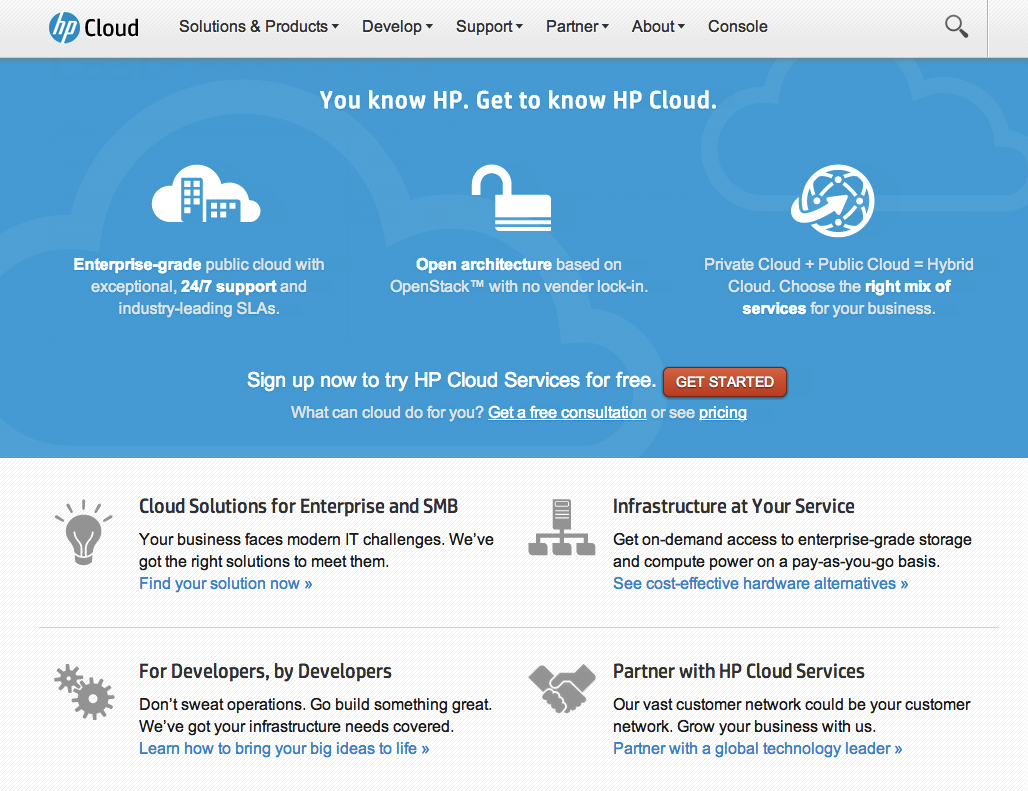
At HP Cloud we just launched a new homepage design (pictured above). The process to craft this landing page is one I think is worth exploring because it can help anyone with their landing pages or even broader products.
The Process and People
I recently wrote about a simple product development process. This is the process I applied to the creation of this new homepage. Following this process had some major benefits that really appeared late in the process. While following a process to design a landing page where design is late in the process may seem odd it actually makes the design work easy while crafting something that works.
Being that HP Cloud, like many organizations, has a number of stakeholders it was important to include the right people at each step while not bringing in everyone for all the steps. When you need to get work done only the people who will contribute to that need to be involved in the development.
Figuring Out The Target Audiences
HP Cloud is a web thing so aren’t all web users the target audience? The answer is obviously no. The hard question is identifying who the target audience is going beyond base demographic information.
For example, if you are targeting a product at Drupal developers you might not be targeting content managers. Or, vice versa. Knowing who the target audience is up front is really important. At HP Cloud we aren’t targeted at Drupal developers but we do know who our audience is.
Before moving on we had a clear and limited list of target audiences for this landing page. This was mapped to the list of personas I maintain because they are really helpful to agree on the details of these audiences.
Goals Goals Goals
When crafting a landing page the goal isn’t to talk about yourself. Goals allow you to aim for a target, measure success, and compare as you tweak things. Once we had target audiences we gathered up the goals for the homepage. Having target audiences before goals I find to be very important. Goals aren’t just goals. They are goals for a target audience.
The Content
Once we had gathered the audiences and goals it was time to craft the content. The fabulous folks in marketing wrote some new content that was:
- Written towards a target audience.
- In prioritized order.
- Written to meet the goals.
When we shared the content, before there was ever a design, there was push back. People would ask, where is my thing on the homepage? Having the target audiences, goals, and prioritized content made it easy to talk through this. When something wasn’t on the homepage (or any landing page) it’s easy to ask how it helps meet a goal for a particular type of audience. If there is no easy justification it’s easy to justify it not being on the page.
The Design
Once all of this is done the design work began. I intentionally held off design to this point so everything would be in place to make it easy. Instead of wondering, going back with lots of questions, or having to be creative on content I was able to just design. Having content in prioritized order was really nice because what you see on the page is the prioritized order. If/when we go to a responsive or mobile design we can flow things based on the priority.
Building It
Once the design was complete and signed off it was time to build it. This is a Drupal site. Ryan Peters took the design and turned it into something editable by our content managers using the base platform we already have in place.